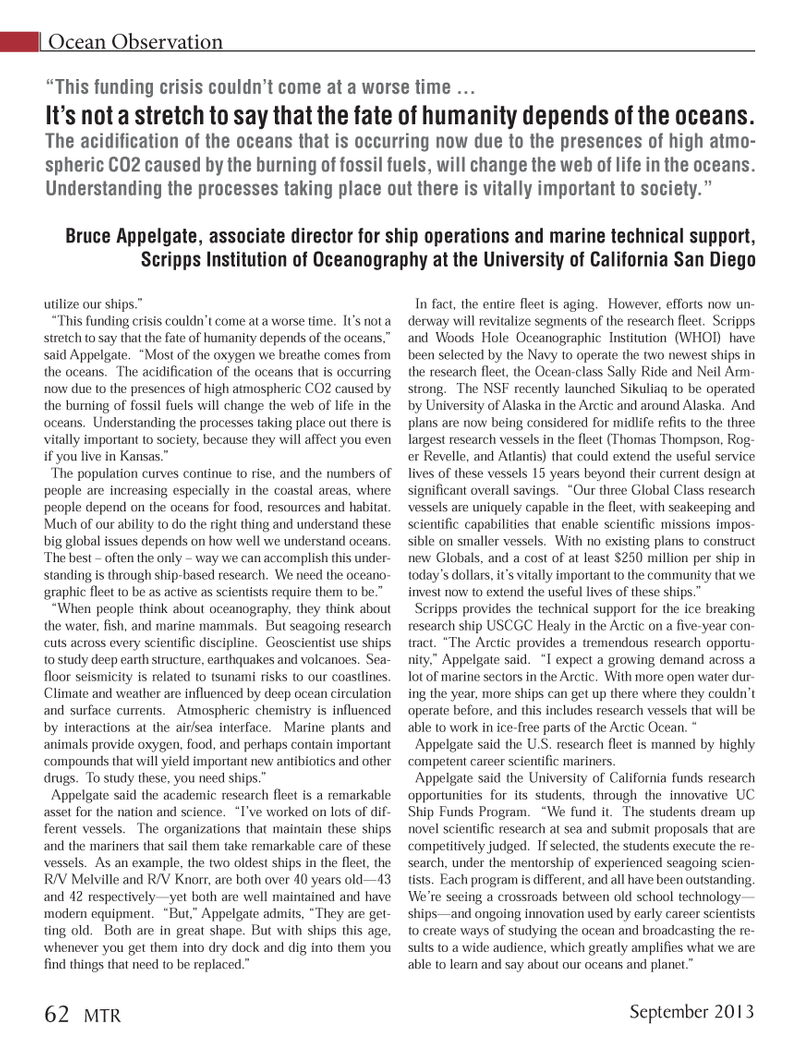
Page 62: of Marine Technology Magazine (September 2013)
Ocean Observation: Gliders, Buoys & Sub-Surface monitoring Networks
Read this page in Pdf, Flash or Html5 edition of September 2013 Marine Technology Magazine
utilize our ships.? ?This funding crisis couldn?t come at a worse time. It?s not a stretch to say that the fate of humanity depends of the oceans,? said Appelgate. ?Most of the oxygen we breathe comes from the oceans. The acidi cation of the oceans that is occurring now due to the presences of high atmospheric CO2 caused by the burning of fossil fuels will change the web of life in the oceans. Understanding the processes taking place out there is vitally important to society, because they will affect you even if you live in Kansas.? The population curves continue to rise, and the numbers of people are increasing especially in the coastal areas, where people depend on the oceans for food, resources and habitat. Much of our ability to do the right thing and understand these big global issues depends on how well we understand oceans. The best ? often the only ? way we can accomplish this under- standing is through ship-based research. We need the oceano- graphic eet to be as active as scientists require them to be.? ?When people think about oceanography, they think about the water, sh, and marine mammals. But seagoing research cuts across every scienti c discipline. Geoscientist use ships to study deep earth structure, earthquakes and volcanoes. Sea- oor seismicity is related to tsunami risks to our coastlines. Climate and weather are in uenced by deep ocean circulation and surface currents. Atmospheric chemistry is in uenced by interactions at the air/sea interface. Marine plants and animals provide oxygen, food, and perhaps contain important compounds that will yield important new antibiotics and other drugs. To study these, you need ships.? Appelgate said the academic research eet is a remarkable asset for the nation and science. ?I?ve worked on lots of dif- ferent vessels. The organizations that maintain these ships and the mariners that sail them take remarkable care of these vessels. As an example, the two oldest ships in the eet, the R/V Melville and R/V Knorr, are both over 40 years old?43 and 42 respectively?yet both are well maintained and have modern equipment. ?But,? Appelgate admits, ?They are get- ting old. Both are in great shape. But with ships this age, whenever you get them into dry dock and dig into them you nd things that need to be replaced.? In fact, the entire eet is aging. However, efforts now un- derway will revitalize segments of the research eet. Scripps and Woods Hole Oceanographic Institution (WHOI) have been selected by the Navy to operate the two newest ships in the research eet, the Ocean-class Sally Ride and Neil Arm- strong. The NSF recently launched Sikuliaq to be operated by University of Alaska in the Arctic and around Alaska. And plans are now being considered for midlife re ts to the three largest research vessels in the eet (Thomas Thompson, Rog- er Revelle, and Atlantis) that could extend the useful service lives of these vessels 15 years beyond their current design at signi cant overall savings. ?Our three Global Class research vessels are uniquely capable in the eet, with seakeeping and scienti c capabilities that enable scienti c missions impos- sible on smaller vessels. With no existing plans to construct new Globals, and a cost of at least $250 million per ship in today?s dollars, it?s vitally important to the community that we invest now to extend the useful lives of these ships.? Scripps provides the technical support for the ice breaking research ship USCGC Healy in the Arctic on a ve-year con- tract. ?The Arctic provides a tremendous research opportu- nity,? Appelgate said. ?I expect a growing demand across a lot of marine sectors in the Arctic. With more open water dur- ing the year, more ships can get up there where they couldn?t operate before, and this includes research vessels that will be able to work in ice-free parts of the Arctic Ocean. ? Appelgate said the U.S. research eet is manned by highly competent career scienti c mariners. Appelgate said the University of California funds research opportunities for its students, through the innovative UC Ship Funds Program. ?We fund it. The students dream up novel scienti c research at sea and submit proposals that are competitively judged. If selected, the students execute the re- search, under the mentorship of experienced seagoing scien- tists. Each program is different, and all have been outstanding. We?re seeing a crossroads between old school technology? ships?and ongoing innovation used by early career scientists to create ways of studying the ocean and broadcasting the re- sults to a wide audience, which greatly ampli es what we are able to learn and say about our oceans and planet.? Ocean Observation ?This funding crisis couldn?t come at a worse time ... It?s not a stretch to say that the fate of humanity depends of the oceans. The acidi cation of the oceans that is occurring now due to the presences of high atmo- spheric CO2 caused by the burning of fossil fuels, will change the web of life in the oceans. Understanding the processes taking place out there is vitally important to society.? Bruce Appelgate, associate director for ship operations and marine technical support, Scripps Institution of Oceanography at the University of California San DiegoSeptember 201362 MTRMTR #7 (50-65).indd 62MTR #7 (50-65).indd 628/22/2013 11:53:41 AM8/22/2013 11:53:41 AM

 61
61

 63
63
